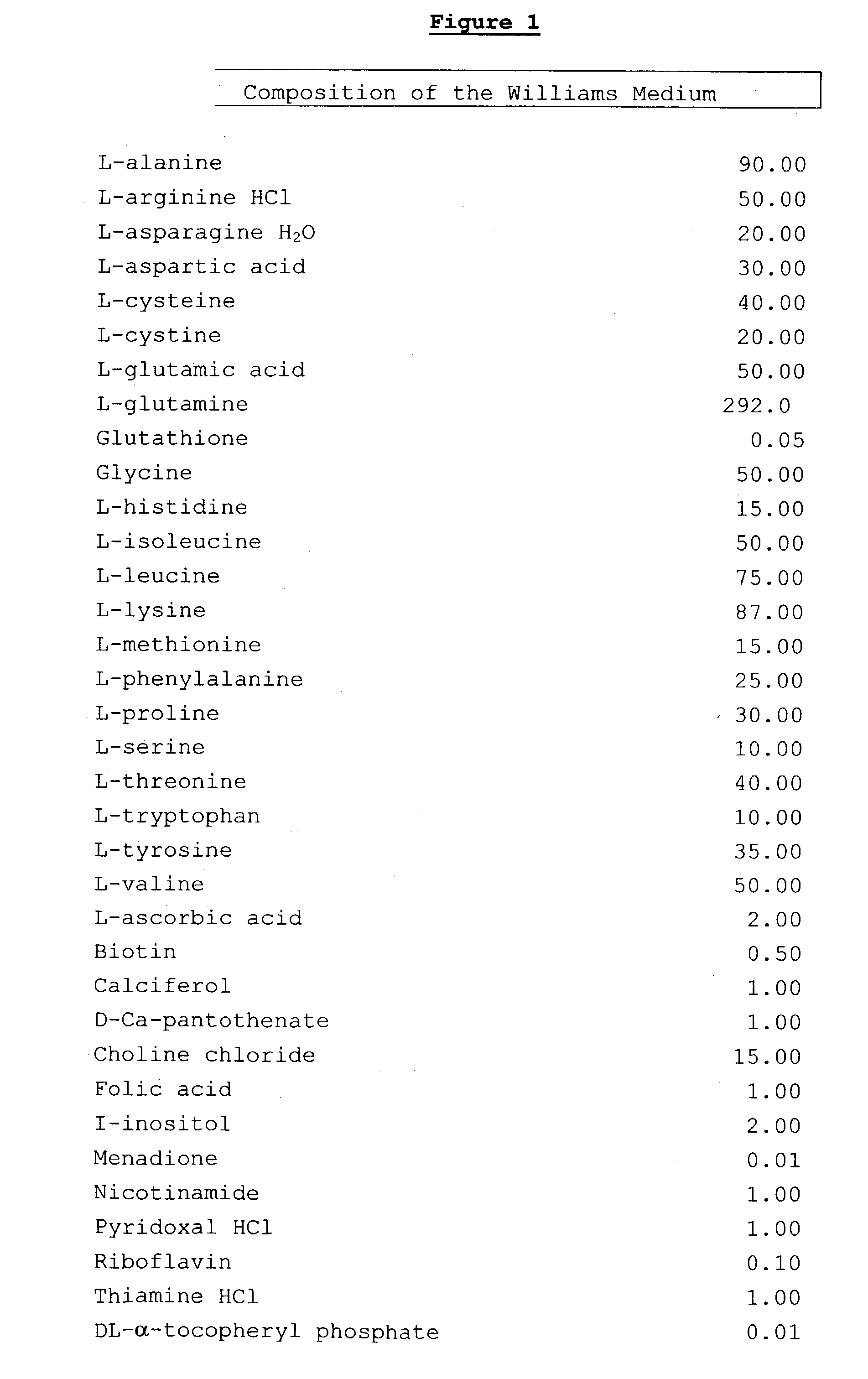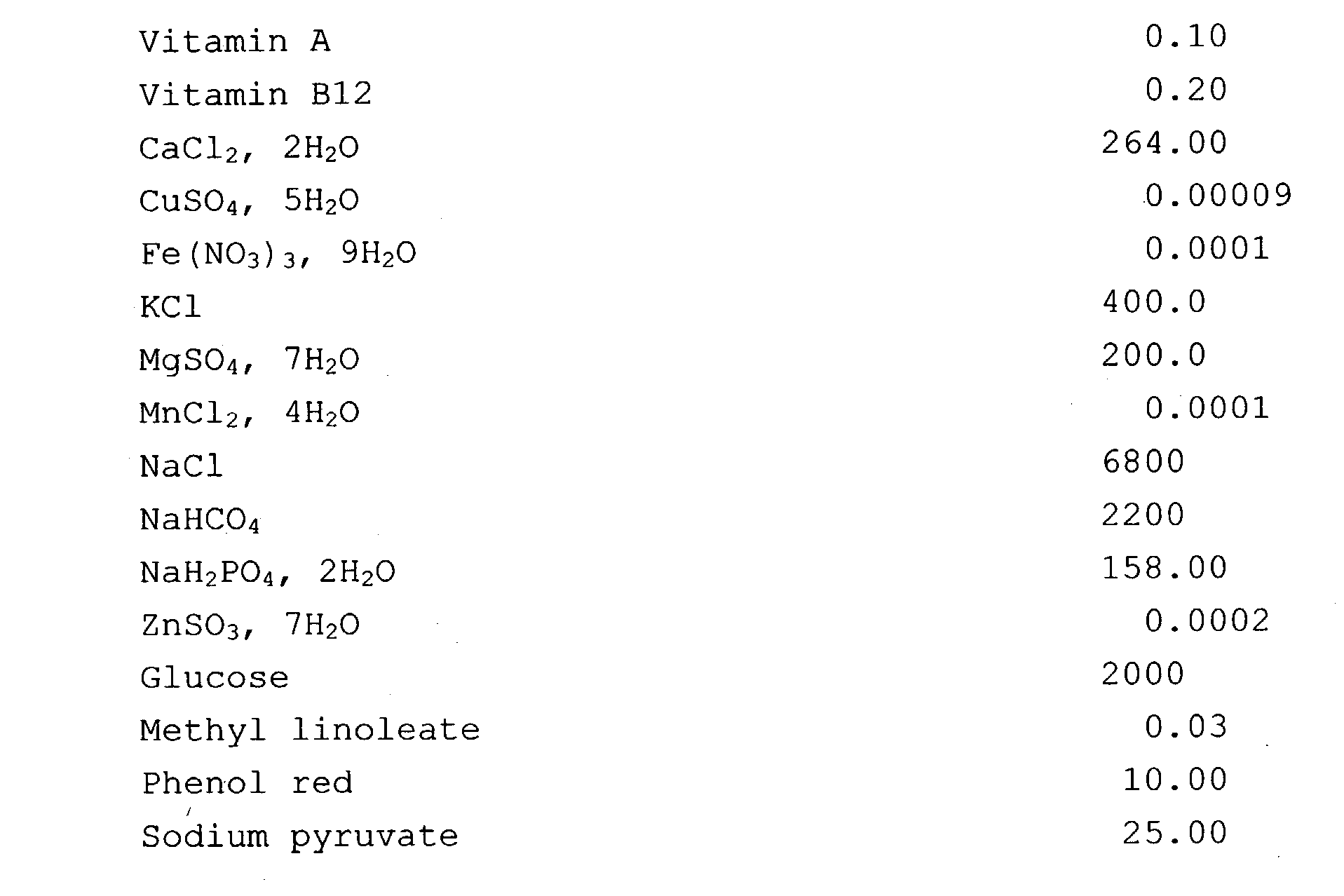Method for producing adherent animal cells
a technology of adherent cells and animal cells, which is applied in the field of producing adherent animal cells, can solve the problems of large amount of proteins in the serum that may not be very well identified, unsuitable culture media for culturing adherent cells, and unsatisfactory culturing of adherent cells. it may also singularly complicate the methods of isolating and purifying cell components and cell derivatives
- Summary
- Abstract
- Description
- Claims
- Application Information
AI Technical Summary
Benefits of technology
Problems solved by technology
Method used
Image
Examples
example 2
Study of the Action of PVP on the Cell Death Rate
[0123] The operating conditions of the study are identical to those developed in paragraphs 1A to 1F.
[0124] The cell death rate is assessed daily by means of the number of dead cells or the measurement of the LDH (lactate dehydrogenase) found in the culture medium. The cell death rate is assessed by means of staining with trypan blue. Starting with a daily withdrawal of 1 ml of cell culture, 1 ml of 10% trypan blue is added. The dead cells which take the stain are counted using a Fuchs-Rosenthal cell. The measurement uncertainty is .+-.10%. The cell death rate results, expressed as the number of cells / ml, are given in Table 3.
[0125] The assessment of the cell death rate can also be determined by means of measuring the lactate dehydrogenase in the culture supernatant. Specifically, it has been shown that an assessment of the cell death rate during fermentation in bioreactors can be performed by measuring the LDH released into the cultu...
example 3
Study of the Action of PVP on the Adhesion of Cells to Their Support
[0130] The operating conditions of the study are identical to those developed in paragraphs 1A to 1F.
[0131] To evaluate the effect of a PVP on the adhesion of cells, the number of cells which have become attached to the microcarriers 4 hours after inoculating the biogenerator or the Spinner according to the technique developed in paragraph 1G is determined. It is considered that, after 4 hours, the Vero cells are still in the same phase of their cell cycle, which means that the number of nuclei counted corresponds to the number of cells attached. The measurement uncertainty is .+-.10%. The results, expressed as the number of cells / ml, are given in the table below.
11TABLE 5 With-drawal N / W N / W + PVP VPSFM / W VPSFM / W + PVP 0 675000* 675000 405000 405000 4 h 453125 787500 394000 439250
[0132] Conclusions:
[0133] These results clearly show that the cell concentration is higher after 4 hours when the serum-free media contai...
example 4
Role of a PVP in the Growth, Adhesion and Mortality of Vero Cells Cultured in Rolling Flasks
[0134] The Vero cells as described in paragraph 1A are inoculated in 300 ml rolling flasks, (Ref.: Falcon 3007) at a rate of 30 000 to 50 000 cells per cm.sup.2 of support. Various defined and nondefined culture media free of serum of animal origin but containing 0.1% of a 40-kd PVP were tested, including those described in paragraph 1A. A 100-kd PVP at 0.5% and also a 360-kd PVP at 0.05% were also tested using the same culture media.
[0135] The Vero cells in suspension in the various culture media tested are then introduced into rolling flasks which are then placed on rollers rotating at a speed of between 0.1 rpm and 0.5 rpm. Four hours after inoculating the flasks, and then daily for 6 days, a study of the growth and adhesion of the cells to the walls of the flask is performed on these rolling flasks, after having removed the culture medium, washed the flasks with a phosphate buffer and det...
PUM
 Login to View More
Login to View More Abstract
Description
Claims
Application Information
 Login to View More
Login to View More - R&D
- Intellectual Property
- Life Sciences
- Materials
- Tech Scout
- Unparalleled Data Quality
- Higher Quality Content
- 60% Fewer Hallucinations
Browse by: Latest US Patents, China's latest patents, Technical Efficacy Thesaurus, Application Domain, Technology Topic, Popular Technical Reports.
© 2025 PatSnap. All rights reserved.Legal|Privacy policy|Modern Slavery Act Transparency Statement|Sitemap|About US| Contact US: help@patsnap.com


